LNER Class A3 4472 Flying Scotsman
| Flying Scotsman | |||||||||||||||||||
|---|---|---|---|---|---|---|---|---|---|---|---|---|---|---|---|---|---|---|---|
 Flying Scotsman in 2003. Despite the LNER livery, the prominent German-style smoke deflectors and double chimney are BR-era features. | |||||||||||||||||||
| |||||||||||||||||||
| |||||||||||||||||||
| |||||||||||||||||||
| |||||||||||||||||||
The LNER Class A3 Pacific steam locomotive No. 4472 Flying Scotsman (originally No. 1472) was built in 1923 for the London and North Eastern Railway (LNER) at Doncaster Works to a design of H.N. Gresley. It was employed on long-distance express trains on the LNER and its successors, British Railways Eastern and North-Eastern Regions, notably on the 10am London to Edinburgh Flying Scotsman train service after which it was named.
The locomotive is notable for having set two world records for steam traction; becoming the first steam locomotive to be officially authenticated at reaching 100 miles per hour (160.9 km/h) on 30 November 1934,[1] and then setting a record for the longest non-stop run by a steam locomotive when it ran 422 miles (679 km) on 8 August 1989.[2]
Retired from regular service in 1963 after covering 2,076,000 miles (3,341,000 km),[1][3][4] Flying Scotsman gained considerable fame in preservation under the ownership of Alan Pegler, William McAlpine, Tony Marchington and finally the National Railway Museum. As well as hauling enthusiast specials in the United Kingdom, the locomotive toured extensively in the United States (from 1969 to 1973) and Australia (from 1988 to 1989). Flying Scotsman has been described as the world's most famous steam locomotive.[5][6]
History
The locomotive was completed in 1923, construction having been started under the auspices of the Great Northern Railway (GNR). It was built as an A1, initially carrying the GNR number 1472, because the LNER had not yet decided on a system-wide numbering scheme.[7]
Flying Scotsman was something of a flagship locomotive for the LNER. It represented the company at the British Empire Exhibition at Wembley in 1924 and 1925. Before this event, in February 1924 it acquired its name and the new number of 4472.[8] From then on it was commonly used for promotional purposes.
With suitably modified valve gear, this locomotive was one of five Gresley Pacifics selected to haul the prestigious non-stop Flying Scotsman train service from London to Edinburgh, hauling the inaugural train on 1 May 1928. For this the locomotives ran with a new version of the large eight-wheel tender which held 9 tons of coal. This and the usual facility for water replenishment from the water trough system enabled them to travel the 392 miles (631 km) from London to Edinburgh in eight hours non-stop. The tender included a corridor connection and tunnel through the water tank giving access to the locomotive cab from the train to permit replacement of the driver and fireman without stopping the train. The following year the locomotive appeared in the film The Flying Scotsman. On 30 November 1934, driven by Bill Sparshatt and running a light test train, 4472 became the first steam locomotive to be officially recorded at 100 mph (160.9 km/h) and earned a place in the land speed record for railed vehicles; the publicity-conscious LNER made much of the fact.[9][1]
On 22 August 1928, there appeared an improved version of this Pacific type classified A3; older A1 locomotives were later rebuilt to conform. On 25 April 1945, A1-class locomotives not yet rebuilt were reclassified A10 in order to make way for newer Thompson and Peppercorn Pacifics. Flying Scotsman emerged from Doncaster works on 4 January 1947 as an A3, having received a boiler with the long "banjo" dome of the type it carries today. By this time it had been renumbered twice: under Edward Thompson's comprehensive renumbering scheme for the LNER, it became no. 502 in January 1946; but in May the same year, under an amendment to that plan, it become no. 103.[7] Following nationalisation of the railways on 1 January 1948, almost all of the LNER locomotive numbers were increased by 60000, and no. 103 duly became 60103 in December 1948.[10]

Between 5 June 1950 and 4 July 1954, and between 26 December 1954 and 1 September 1957, under British Railways ownership, it was allocated to Leicester Central shed on the Great Central, running Nottingham Victoria to London Marylebone services via Leicester Central.
All A3 Pacifics were subsequently fitted with a double Kylchap chimney to improve performance and economy. This caused soft exhaust and smoke drift that tended to obscure the driver's forward vision; the remedy was found in the German-type smoke deflectors fitted from 1960, which somewhat changed the locomotives' appearance but solved the problem.[11]
Preservation
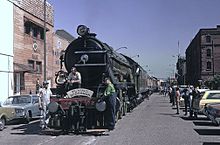
In 1962, British Railways announced that they would scrap Flying Scotsman.[12] Number 60103 ended service with its last scheduled run on 14 January 1963.[13]
Proposed to be saved by a group called "Save Our Scotsman", they were unable to raise the required £3,000, the scrap value of the locomotive. Having first seen the locomotive at the British Empire Exhibition in 1924,[14] in 1961 Alan Pegler had received £70,000 for his share holding when Northern Rubber was sold to Pegler's Valves, a company started by his grandfather.[15] Peglar stepped in and bought the locomotive outright, with the political support of Harold Wilson.[16] He spent the next few years spending large amounts of money having the locomotive restored at Doncaster Works as closely as possible to its LNER condition: the smoke deflectors were removed; the double chimney was replaced by a single chimney; and the tender was replaced by one of the corridor type with which the locomotive had run between 1928 and 1936. It was also repainted into LNER livery, although the cylinder sides were painted green, whereas in LNER days they were always black. Peglar then persuaded the British Railways Board to let him run enthusiasts specials, then the only steam locomotive running on mainline British Railways.[16] It worked a number of rail tours, including a non-stop London–Edinburgh run in 1968 – the year steam traction officially ended on BR. In the meantime, the watering facilities for locomotives were disappearing, so in September 1966 Pegler purchased a second corridor tender, and adapted as an auxiliary water tank; retaining its through gangway, this was coupled behind the normal tender.[17]

Pegler had a contract permitting him to run his locomotive on BR until 1972, but following overhaul in the winter of 1968–69 then Prime Minister Wilson agreed to support Pegler via the Trade Department running the locomotive in the United States and Canada to support British exports. To comply with local railway regulations, it was fitted with: a cowcatcher; bell; buckeye couplings; American-style whistle;[18] air brakes; and high-intensity headlamp. Starting in Boston, Massachusetts,[15] the tour ran into immediate problems, with some states seeing the locomotive as a fire-hazard, and there-by raising costs through the need for diesel-headed-haulage through them. However, the train ran from Boston to New York, Washington and Dallas in 1969; from Texas to Wisconsin and finishing in Montreal in 1970; and from Toronto to San Francisco in 1971 — a total of 15,400 miles (24,800 km).[14]
However, in 1970 Ted Heath's Conservatives ousted Wilson's Labour Party, and withdrew financial support from the tour; but Pegler decided to return for the 1970 season. By the end of that season's tour, the money had run out and Pegler was £132,000 in debt, with the locomotive in storage at the U.S. Army Sharpe Depot to keep it away from unpaid creditors.[14] Pegler worked his passage home from San Francisco to England on a P&O cruise ship in 1971, giving lectures about trains and travel; he was declared bankrupt in the High Court 1972.[16][15][14][19]

Fears then arose for the engine's future, the speculation being that it could take up permanent residence in America or even be cut up. After Alan Bloom made a personal phone call to him in January 1973, William McAlpine stepped in and bought the locomotive for £25,000 direct from the finance company in San Francisco docks. After its return to the UK via the Panama Canal in February 1973, McAlpine paid for the locomotive's restoration at Derby Works. Trial runs took place on the Paignton and Dartmouth Steam Railway in summer 1973, after which it was transferred to Steamtown (Carnforth), from where it steamed on various tours.[20]
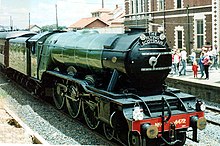
In October 1988 the locomotive arrived in Australia[22] to take part in that country's bicentenary celebrations as a central attraction in the Aus Steam '88 festival. During the course of the next year it travelled more than 45,000 kilometres (28,000 mi) over Australian rails, concluding with a return transcontinental run from Sydney to Perth via Alice Springs in which it became the first steam locomotive to travel on the recently built standard gauge Central Australia Railway.[23] Other highlights included Flying Scotsman double-heading with NSWGR Pacific locomotive 3801, a triple-parallel run alongside broad gauge Victorian Railways R class locomotives, and parallel runs alongside South Australian Railways locomotives 520 and 621. Its visit to Perth saw a reunion with GWR 4073 Class Pendennis Castle, which had been exhibited alongside Flying Scotsman at the 1924 British Empire Exhibition.[24] On 8 August 1989 Flying Scotsman set another record en route to Alice Springs from Melbourne, travelling 679 kilometres (422 mi) from Parkes to Broken Hill non-stop, the longest such run by a steam locomotive ever recorded.[5] The same journey also saw Flying Scotsman set its own haulage record when it took a 735 ton train over the 490-mile (790 km) leg between Tarcoola and Alice Springs.[25]
Returned to the UK, by 1995 it was in pieces at Southall Railway Centre in West London, owned by a consortium that included McAlpine as well as music guru and well-known railway enthusiast Pete Waterman. Facing an uncertain future owing to the cost of restoration and refurbishment necessary to meet the stringent engineering standards required for main line operation, salvation came in 1996 when Dr Tony Marchington, already well known in the vintage movement, bought the locomotive, and had it restored over three years to running condition at a cost of £1 million,[26] a restoration which is still recognised as the most extensive in the locomotive's history. Marchington's time with the Flying Scotsman was documented in on documentary, the Channel 4 programme A Steamy Affair: The Story of Flying Scotsman.[27]
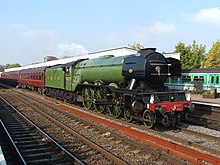
With Flying Scotsman's regular use both on the VSOE Pullman and with other events on the main line, in 2002, Marchington proposed a business plan, which included the construction of a "Flying Scotsman Village" in Edinburgh, to create revenue from associated branding. After floating on OFEX as Flying Scotsman plc in the same year,[27] in 2003 Edinburgh City Council turned down the village plans, and in September 2003 Marchington was declared bankrupt.[28] At the company's AGM in October 2003, CEO Peter Butler announced losses of £474,619, and with a £1.5 million overdraft at Barclays Bank, stated that the company only had enough cash to trade until April 2004. The company's shares were suspended from OFEX on 3 November 2003 after it had failed to declare interim results.[28]
With the locomotive effectively placed up for sale, after a high-profile national campaign it was bought in April 2004 by the National Railway Museum in York,[29] and it is now part of the National Collection. After 12 months of interim running repairs, it ran for a while to raise funds for its forthcoming 10-year major boiler recertification.
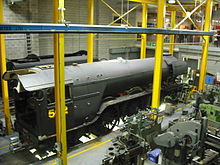
In January 2006, Flying Scotsman entered the Museum's workshops for a major overhaul to return it to Gresley's original specification and in order to renew its boiler certificate; originally planned to be completed by mid 2010 if sufficient funds were raised,[30][31][32] but late discovery of additional problems meant it would not be completed on time.[33][34][35] In October 2012, the Museum published a report examining the reasons for the delay and additional cost. [36] The locomotive was moved in October 2013 to Bury for work to return it to running condition in 2015.[37]
The bay in which the locomotive was being refurbished was on view to visitors to the NRM but the engine was rapidly dismantled to such an extent that the running plate was the only component recognisable to the casual observer. Early in 2009 it emerged that the overhaul would see the loco reunited with the last remaining genuine A3 boiler (acquired at the same time as the locomotive as a spare). The A4 boiler that the loco had used since the early 1980s was sold to Jeremy Hosking for potential use on his locomotive, LNER Class A4 4464 Bittern.[38]
Debate over restoration
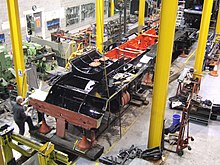
Choice of livery is an emotive subject amongst some of those involved in the preservation of historic rolling stock, and Flying Scotsman has attracted more than its fair share[citation needed] due to 40 years continuous service, during which the locomotive underwent several changes to its livery.
Alan Pegler's preferred option was evidently to return the locomotive as far as possible to the general appearance and distinctive colour it carried at the height of its fame in the 1930s. A later option was to re-install the double Kylchap chimney and German smoke deflectors that it carried at the end of its career in the 1960s, which encouraged more complete combustion, a factor in dealing with smoke pollution and fires caused by spark throwing.
More recently, until its current overhaul it was running in a hybrid form, retaining the modernised exhaust arrangements while carrying the LNER 'Apple Green' livery of the 1930s. Some believe that the more famous LNER colour scheme should remain, while others take the view that, to be authentic, only BR livery should be used when the loco is carrying these later additions. The subject is further complicated by the fact that, while in BR livery, the locomotive never ran with its corridor tender.
The National Railway Museum (NRM) announced on 15 February 2011, that Flying Scotsman will be painted in LNER Wartime Black livery when it undergoes its steam tests and commissioning runs. The letters 'NE' appear on the sides of the tender, along with the number '103' on one side of the cab and '502' on the other – the numbers it was given under the LNER's renumbering system. Flying Scotsman will be repainted in its familiar-look Apple Green livery in the summer, but remained in black for the NRM's Flying Scotsman Preview Weekend which took place on 28–30 May 2011. Furthermore, during the National Railway Museum's 'railfest' event on 2–10 June 2012, Flying Scotsman was in attendance, being kept in front of Mallard in a siding, still in its Wartime Black livery.[39] A report on the restoration was published, in redacted form, on 7 March 2013.[40]
In popular culture
Because of the LNER's emphasis on using the locomotive for publicity purposes, and then its eventful preservation history, including two international forays, it is arguably one of the most famous locomotives in the world today[citation needed], and no doubt among the most famous in the UK. One of its first film appearances was in the 1929 film The Flying Scotsman, which featured an entire sequence set aboard the locomotive.[41]
Flying Scotsman was featured in The Railway Series books by the Rev. W. Awdry. The locomotive visited the fictional Island of Sodor in the book Enterprising Engines. At this time it had two tenders, and this was a key feature of the plot of one of the stories, "Tenders for Henry". When the story was filmed for the television series Thomas & Friends, renamed as "Tender Engines" only Flying Scotsman's two tenders were seen outside a shed.[42] He originally was intended to have a larger role in this episode, but because of budgetary constraints, the modelling crew could not afford to build the entire engine.[43]
The locomotive was the first choice for the "Top Gear Race to the North", though due to an overhaul was unable to attend, so the position went to LNER Peppercorn Class A1 60163 Tornado instead.[44]
A model of the Flying Scotsman appeared in Episode 6 and The Great Train Race episodes of James May's Toy Stories. It was James May's personal childhood model and was chosen by him to complete a world record for the longest model railway.[45] The train was meant to travel 7 miles from Barnstaple to Bideford, in North Devon and it failed early in the trip in Episode 6[45] but managed to complete it in The Great Train Race which took place on 16 April 2011.[46]
One of the specially produced £5 coins for the 2012 Summer Olympics featured an engraving of the Flying Scotsman on the back.[4]
"Flying Scotsman" is included as a locomotive in the PC simulation game Microsoft Train Simulator.[47]
References
- ^ a b c "British Railway Heritage - 4472 The Flying Scotsman". theheritagetrail.co.uk. Retrieved 6 December 2012.
- ^ Malpass, Dare & Jenkins (1992). A Vintage Year for Steam. Melbourne: Australian Railway Historical Society. pp. 112, 121.
- ^ "Hornby Direct Hormby Railroad R3086 Flying Scotsman". Retrieved 31 October 2012.
- ^ a b "The Flying Scotsman". The Royal Mint. Retrieved 31 October 2012.
- ^ a b Malpass, Dare & Jenkins (1992). A Vintage Year for Steam. Melbourne: Australian Railway Historical Society. p. 97.
- ^ David Clifford (1997). The World's Most Famous Steam Locomotive - Flying Scotsman. Swanage: Finial Publishing. ISBN 1-900467-02-X.
- ^ a b Boddy, M.G.; Neve, E.; Yeadon, W.B. (1986) [1973]. Fry, E.V. (ed.). Part 2A: Tender Engines – Classes A1 to A10. Locomotives of the L.N.E.R. Kenilworth: RCTS. p. 9, inside back cover. ISBN 0-901115-25-8.
{{cite book}}: Invalid|ref=harv(help); Unknown parameter|month=ignored (help) - ^ Boddy, Neve & Yeadon 1986, pp. 9, 73, inside back cover
- ^ "National Rail Museum appeal on Flying Scotsman". Nottingham Post. Nottingham. 22 January 2009. Retrieved 22 December 2013.
- ^ Boddy, Neve & Yeadon 1986, inside back cover
- ^ Reed Brian "LNER non-streamlined Pacifics" Profile Publications, Windsor, UK. Undated – 1960s: p. 22
- ^ Herring, Peter (2002). Yesterday's Railways. David & Charles. p. 130.
- ^ "Anniversaries of 2013". Daily Telegraph. 28 December 2012.
- ^ a b c d "Obituary - Alan Peglar" (PDF). The Times. 25 March 2012. Retrieved 25 May 2013.
- ^ a b c Johnson, Peter (25 March 2012). "Alan Pegler obituary". The Guardian.
- ^ a b c "Obituary - Alan Peglar". Daily Telegraph. 25 March 2012. Retrieved 25 May 2013.
- ^ Boddy, Neve & Yeadon 1986, pp. 68–69, 70, 88
- ^ Boddy, Neve & Yeadon 1986, p. 88
- ^ Ffestiniog & Welsh Highland Railways - Alan Francis Pegler OBE
- ^ "Sir William McAlpine talks to Andy Milne". Railway people. 20 June 2006.
- ^ Malpass, Dare & Jenkins (1992). A Vintage Year for Steam. Melbourne: Australian Railway Historical Society. p. 98.
- ^ O'Neil, Shane (August 2008). "Flying Scotsman's Australian Visit: 20 Years on". Australian Railway History: 265–272.
- ^ Malpass, Dare & Jenkins (1992). A Vintage Year for Steam. Melbourne: Australian Railway Historical Society. p. 59.
- ^ Malpass, Dare & Jenkins (1992). A Vintage Year for Steam. Melbourne: Australian Railway Historical Society. pp. 64, 66.
- ^ Batchelder, Alf (June 2013), "Memories of the Flying Scotsman in 1988: Farewell", Branchline, Castlemaine and Maldon Railway Preservation Society: p. 7
{{citation}}:|pages=has extra text (help) - ^ "Scotsman flying high". BBC News. 14 April 1999. Retrieved 16 January 2011.
- ^ a b "Dr Tony Marchington confirmed as Dinner speaker". Integra Communications. Retrieved 16 January 2011.[dead link]
- ^ a b Michael Williams (8 February 2004). "Flying Scotsman may be sold abroad". The Independent. Retrieved 16 January 2011.
- ^ Scott, Andrew (2004). "How we saved the Flying Scotsman". Railway Magazine. 150 (1238): 14–19.
{{cite journal}}: Unknown parameter|month=ignored (help) - ^ "NRM – Keep Scotsman Steaming Appeal!". Flyingscotsman.org.uk. Retrieved 21 December 2012.
- ^ Courtney, Geoff (2009). "NRM in £250K Flying Scotsman boiler SOS". Heritage Railway. 120: 8–10.
{{cite journal}}: Unknown parameter|month=ignored (help) - ^ Streeter, Tony (2009). "Flying Scotsman – the real story". Steam Railway. 359: 60–2.
{{cite journal}}: Unknown parameter|month=ignored (help) - ^ "Flying Scotsman due to return late spring 2012". National Railway Museum. 30 September 2011. Archived from the original on 22 October 2011.
- ^ Boyd-Hope, Gary (14 October–10 November 2011). "Flying Scotsman will not return until late spring, says NRM". Steam Railway. 394: 6–7.
{{cite journal}}: Check date values in:|date=(help) - ^ Jones, Robin (27 October–23 November 2011). "Flying Scotsman: repair bill to hit £2.6 million". Heritage Railway. 156: 36–7.
{{cite journal}}: Check date values in:|date=(help) - ^ Meanley, Robert (26 November 2012). "A report for the Trustees of the Science Museum Group into the restoration of A3 Class Pacific Flying Scotsman and associated engineering project management". National Railway Museum. Archived from the original (PDF) on 10 November 2012.
- ^ National Railway Museum. "http://www.nrm.org.uk/AboutUs/PressOffice/PressReleases/2013/October/scotsman-update-Oct2013.aspx". Retrieved 4 November 2013.
{{cite web}}: External link in|title= - ^ Courtney, Geoff (2009). "NRM sells Scotsman boiler in hush-hush deal". Heritage Railway. 121: 6.
{{cite journal}}: Unknown parameter|month=ignored (help) - ^ "Wartime black livery for Flying Scotsman". 15 February 2011. Retrieved 11 March 2011.
- ^ http://www.nrm.org.uk/aboutus/~/media/Files/NRM/PDF/NRM%20Flying%20Scotsman%20Final%20Report.pdf
- ^ Fuller, Graham (2011). "DVD: The Flying Scotsman (1929) | Film reviews, news & interviews". The Arts Desk. Retrieved 31 October 2012.
{{cite web}}: Unknown parameter|month=ignored (help) - ^ Rev. W. Awdry (author, Enterprising Engines), Britt Allcroft (producer), David Mitton (director) (1992-02-17). "Tender Engines". Thomas and Friends. Episode 20. ITV.
{{cite episode}}: Unknown parameter|serieslink=ignored (|series-link=suggested) (help); Unknown parameter|seriesno=ignored (|series-number=suggested) (help) - ^ "Steve Asquith – 25 Years On The Model Unit". Retrieved 8 July 2010.
- ^ Steam Railway Magazine. Issue 363. Bauer Media Group. 29 May – 25 June 2009.
{{cite journal}}: External link in|volume=|title=(help) - ^ a b "BBC Two- James May's Toy Stories, Series 1, Hornby". BBC. Retrieved 31 October 2012.
- ^ "BBC Two - James May's Toy Stories, The Great Train Race". BBC. Retrieved 31 October 2012.
- ^ "Microsoft Train Simulator". Deafgamers. Retrieved 27 December 2012.
Further reading
- Clifford, David (comp.) (1997). The world's most famous steam locomotive: Flying Scotsman. Swanage: Finial. ISBN 1-900467-02-X.
- Harris, Nigel (ed.) (1988). Flying Scotsman – a locomotive legend. St Michaels on Wyre: Silver Link Publishing.
{{cite book}}:|author=has generic name (help) - Hughes, Geoffrey (2004). Flying Scotsman: the people’s engine. York: Friends of the National Railway Museum Enterprises. ISBN 0-9546685-3-7.
- Nicholson, Peter (1999). Flying Scotsman – the world's most travelled steam locomotive. Shepperton: Ian Allan. ISBN 0-7110-2744-7.
- Pegler, Alan; et al. (1976). Flying Scotsman (3rd ed.). Shepperton: Ian Allan. ISBN 0-7110-0663-6.
{{cite book}}: Explicit use of et al. in:|author=(help) - Roden, Andrew (2007). Flying Scotsman. London: Aurum. ISBN 978-1-84513-241-5.
- Sharpe, Brian (2005). Flying Scotsman: the legend lives on. Horncastle: Mortons Media.
External links
- National Railway Museum's site about Flying Scotsman train and locomotive
- The official National Railway Museum print website containing many Flying Scotsman prints and posters
- Photo: from Gresley Society[dead link]
- BBC "Nation on Film" article with historic films of Flying Scotsman in steam.
- The LNER Encyclopedia page for the Gresley A1/A3s including Flying Scotsman
- History of the Flying Scotsman by Southern Steam Trains
